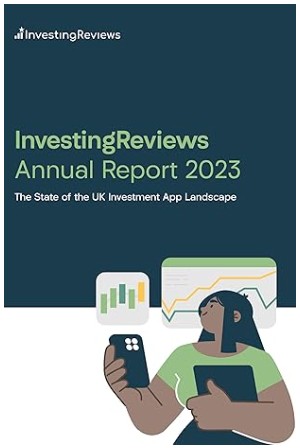Our UK investment apps survey sought to understand the different investing platforms that exist across the UK market, and how well they are servicing a diverse set of consumer needs.
We explored the different investment apps that exist, from traditional players like Interactive Investor and Hargreaves Lansdown, to newcomers like Lightyear and Wealthyhood as well as the underlying needs and wants of consumers when engaging with their investing platforms.
Continue reading extracts from our report or download the full InvestingReviews Report: The State of the UK Investment App Landscape in PDF format. Also available on Amazon Kindle.
- Executive summary – Top 10 findings
- UK Investment Apps Survey: Our Approach
- Most commonly used investing apps
- Demographics: Gender
- Demographics: Age
- Demographics: Household Income
- Behaviours: Number of Investments
- Behaviours: Types of Asset Owned
- Behaviours: Portfolio Value
- Behaviours: Usage Behaviour
- Behaviours: Net Promoter Score (NPS)
- App Preferences: Investment App Choice
- App Preferences: Number of Finance Apps Used
- App Preferences: Investment App Choice
- App Preferences: The Appetite for Super-apps?
- Features and Task Analysis
- Investment Platform Advertising Spend
- Final thoughts
Executive summary – Top 10 findings
- Gender split and platform skew – Our survey suggested a 70/30 male/ female investor split, and women are more likely to invest in managed portfolios, suggesting women are more savings savvy than men perhaps.
- Age – Younger investors are more likely to be attracted to app-only platforms, especially those offering free shares for recommending friends and family. What does this mean for the future of heritage investment platforms?
- Household income – The most popular apps for low income households (less than £25K annual income) are Trading 212 and Freetrade and for higher household incomes (more than £75K annual income) are Fidelity and Wealthify. Is this a reflection of their desired target market or just a natural course?
- Number of investments – The average portfolio value was £1-5K with just over 50% of our panel in this bracket. The most popular platforms for larger portfolios (£50K+) are Fidelity and Hargreaves Lansdown. Trading212, Freetrade & eToro are the most popular platforms for smaller portfolios of £1,000 or less. Are these smaller customers profitable?
- Return on Advertising – Spend Whilst big spenders on advertising like eToro dominate, this does not suggest larger portfolio values. Clearly tactics like upselling retail investors from stocks and shares to CFDs and forex trading is their aim?
- App usage – Frequency of use was high but trading frequency was not. Trade frequency was low especially amongst lower income households. Behaviour – Checking vs doing – Voyeurism perhaps?
- Net Promoter Score – Of those surveyed, the brands most likely to be recommended include Interactive Investor & Trading 212 with the least likely being Nutmeg and Wealthify. Is this a true reflection or just clients miffed with the recent bear market performance?
- Other apps used – No single investment app seems to service all users’ needs. Some have more than one app for investing and trading, suggesting that either free share offers or different assets available?
- Feature rankings – Saturation in the market suggests most investment platforms and apps are successfully meeting customer needs and offer very little other points of differentiation.
- Take note: Themes of industry – Any mergers or acquisitions will experience potential huge duplication of customer accounts where 90 percent have more than one account and with small amounts invested.

We have witnessed the stratospheric rise of new investing platforms launching and adjacent players, (including neobanks and trading platforms) broadening their services to include investing capabilities.
This growth has seen a big increase in competition as these new platforms jostle for position to acquire customers with differentiation and competitive advantage becoming ever harder.
With the rise of investment infrastructure providers such as Seccl or WealthKernel and the continued ease of access to technology, the barriers to creating investing platforms have significantly decreased. Now, new
FinTech businesses can leverage partners across their entire technology ecosystem to significantly bring down the cost and barriers of launching new investing platforms. But this comes at a cost, which we go into more detail in our report.
As we dive into this report to uncover the type of investors our market is serving, we delved deeper into how their behaviours and preferences change across different platforms and where the untapped innovation opportunities lie for the industry.
Whilst developing the research, our hunch was that whilst the UK is a global fintech leader, the market is over-served and saturated with investment apps…

UK Investment Apps Survey: Our Approach
Our research was gathered from a UK representative sample of 1,000 UK investors, sourced from Behind Login’s consumer panel.
To uncover the trends and insights from our research participants, we created a survey to understand the different types of investor that exist in the market, from demographic data such as age, gender, and income, to investor behaviour data such as frequency of trading, number of investments, and engagement with platforms.
From our research sample there were 45 different apps that participants use to invest, which is a huge selection available to UK investors and a reflection on the saturation of the market.
To ensure our research remains statistically significant we only conducted platform-level analysis on the top 10 platforms that had large enough numbers of responses to ensure confidence in our data integrity.
Our questions that explore demographic and behavioural insights leverage our entire 1,000 participants.
Most commonly used investing apps
From our survey responses, the most commonly used investing apps are:
- Trading212
- Hargreaves Lansdown
- Freetrade
- eToro
- AJ Bell
- Moneybox
- Fidelity
- Wealthify
- Interactive Investor
- Nutmeg

Demographics: Gender
When analysing the typical investor landscape from a gender perspective, we found research from Boring Money showed that there are 6.4 million female investors, compared to 9.7 million male investors in the UK; that’s a 60/40 male/female split.
Our survey followed a similar pattern, with a slightly more male bias with a 70/30 male/ female split.
Highlights
The most popular investing apps amongst women from our panel are:
- Moneybox (42% female)
- Nutmeg (41% female)
- Wealthify (39% female)
These apps all provide managed investment portfolios over individual stocks and share trading; an interesting insight into the preferences of female investors.
The least popular investing apps for females were eToro and Interactive Investor, and the more traditional investing platforms with trading capabilities, further backing up the insight that managed investment portfolios are preferable for women.
Demographics: Age
From our research, as a percentage of the total responses, the most popular investing apps for different age groups are shown in the table below:
| Age Range | Platform |
|---|---|
| 18-24 | Trading212 |
| 25-34 | eToro |
| 35-44 | Moneybox |
| 45-55 | Interactive Investor |
| 55-64 | Fidelity |
| 65-74 | Fidelity |
| 75+ | Hargreaves Lansdown |
Highlights
From our survey, evidence suggests that younger investors prefer app-first investing platforms, and older investors prefer more traditional and well-known platforms.
Perhaps this is because older investors started investing before the app-first investing platforms hit the market, and are less likely to transfer to using an investment app, and younger investors are tempted by newer platforms with better service.

Demographics: Household Income
Our survey explored the average household income of investors across different platforms. The majority (47%) of our participants sat within the £25,000 to £49,999 bracket.
The most popular apps for low income households (less than £25K annual income) are Trading 212 and Freetrade and for higher household incomes (more than £75K annual income) are Fidelity and Wealthify.
We would expect lower income investors to favour price-sensitive platforms, such as Freetrade with its fractional shares and zero commission offer.
For high income investors we would expect to see them prefer more established and premium platforms and apps such as Hargreaves Lansdown or Interactive Investor.
Behaviours: Number of Investments
Interestingly from our panel, just under half (46%) only have 1-3 investments in their portfolio.
No. Investments
- 1 (11.2%)
- 1-3 (35.2%)
- 3-5 (19.4%)
- 5-10 (17.5%)
- 10-20 (9.6%)
- 20+ (7.0%)
Whilst diversification of portfolios has always been suggested as being critical to risk mitigation and long term investing success, it doesn’t look like consumers have taken the advice!
This might indicate that people are taking up the free fractional shares and recommend-a-friend promotions from the likes of Freetrade and Trading212, and doing little or nothing else.
However, the most popular platforms for over 10 investments are Trading212, AJ Bell, and Interactive Investor. Perhaps this is no surprise with AJ Bell and Interactive Investor being older, more traditional platforms. Better diversification perhaps and pre-app revolution?
Interestingly; Trading 212 launched in 2004 as a forex trading platform, but didn’t launch in the UK with commission-free share trading until 2017.
To get free fractional shares worth up to 100 EUR/GBP, you can open an account with Trading 212 through this link. Terms apply”.

Behaviours: Types of Asset Owned
We asked our panel about the type of assets they hold in their investing apps.
Assets owned
- Stocks & Shares 53.70%
- Managed Funds 15.84%
- Passive Funds & ETFs 19.83%
- Foreign Exchange (FX) 2.96%
- Crypto 7.66%
Highlights
- Over half (54%) hold stocks and shares
- A third (36%) have managed and passive funds
- Only a slim percentage (10%) has FX and crypto.
Analysis
Over half (54%) hold stocks and shares, and when you compare this with the ‘total number of investments’ people have in their portfolio it identifies a serious lack of diversification (or a lot of people taking advantage of “free share” offers and doing nothing else).
Crypto and FX scored low in popularity indicating users either invest these assets on alternative platforms or they aren’t very popular with investors. This may present an opportunity for platforms to broaden their offering to include more asset types and look after more of investors’ portfolios.

Behaviours: Portfolio Value
The average portfolio value throughout our survey was £1-5K with just over 50% of our panel in this bracket.
Portfolio value
- <£1,000 (25.8%)
- £1,000 – £5,000 (24.8%)
- £5,000 – £10,000 (15%)
- £10,000 – £20,000 (11.7%)
- £20,000 – £50,000 (10.1%)
- £50,000 – £100,000 (6.4%)
- £100K + (6.2%)
The most popular platforms for larger portfolios (£50K+) are Fidelity and Hargreaves Lansdown. These are both some of the heritage platforms on the market and as such consumers have had longer to build up their portfolios. It will be interesting to see how this data shifts as the newer platforms continue to serve customers.
Trading212, Freetrade, & eToro are the most popular platforms for smaller portfolios of £1,000 or less. These companies often have low barriers to entry, low/no platform fees and often provide incentives to sign up, which might indicate why they are popular for lower portfolio consumers.

Behaviours: Usage Behaviour
In this section of our survey, we looked at the themes and common behaviours of investors. How frequently they trade, how often they check their app, and the various tasks whilst using their app.
Highlights
- Most people use their investing platform at least once a week.
- Freetrade, eToro, and Trading212 ranked as the most frequently used platforms with investors checking daily or even multiple times a day.
- 36% of investors trade monthly and 31% trade less than once a Quarter.
- The least frequently used platforms were Vanguard, Wealthify, and Nutmeg. All these platforms provide managed funds, which require less active management.
- 55% of people use their investing platform for less than 5 minutes per time.
- The most popular platforms for quick sessions of 1-3 minutes are Wealthify and Nutmeg.
- AJ Bell and Fidelity are the investing platforms with the longest user sessions of 5 minutes or more.
- Trading212 and eToro are platforms with the highest frequency traders with 34% and 35% trading once a week respectively.
Analysis
Evidence has identified that the more people trade, the worse their overall portfolios perform. Higher frequency app usage is indicative of higher trading activity and therefore puts these platforms at risk of negatively impacting investors.
It is evident that more people are frequently opening their app, checking on performance vs doing things like actually investing, buying, or selling shares.
Behaviours: Net Promoter Score (NPS)
NPS measures customer loyalty and satisfaction by asking consumers how likely they are to recommend a product or service to a friend. In general, across all industries, brands have scores of around 31 to 50 out of 100.
| App | Score |
|---|---|
| Interactive Investor | 25 |
| Trading 212 | 20 |
| Fidelity | 19 |
| Moneybox | 18 |
| Hargreaves Lansdown | 15 |
| Freetrade | 7 |
| AJ Bell | 0 |
| eToro | -1 |
| Wealthify | -11 |
| Nutmeg | -14 |
Thoughts?
The data in the table above shows that investing apps generally have lower NPS scores than all other industries. Does the overall NPS suggest a lack of long-term investment strategy coupled with poor performance in the markets, where investors are blaming their chosen investment platform?

App Preferences: Investment App Choice
In this section of the survey we asked why they chose a specific investment app, with the option to select from the list below.
What are the main reasons for choosing this investment app?
- Brand Reputation (18.1%)
- Price / Value (15.6%)
- Convenience (15.5%)
- Customer Service (15.5%)
- User Experience (14.1%)
- Recommendation (12.1%)
- Breadth of Features (5%)
- Stability & Up-time (4.2%)
Analysis
Consumers favoured brand reputation above everything else when it comes to choosing an investment app, which goes to show the power of a brand and the importance of perception. Price came in at the second most important reason to choose an investment app, indicating the price sensitivity of consumers, and the need for investing platforms to offer attractive rates.
As predicted the more traditional platforms such as AJ Bell, HL and Fidelity are favoured for their brand reputation. Freetrade customers were the only ones that cited ‘price’ as the most important factor, the clues in the name on that one. Interestingly eToro and Trading 212 both had User Experience as they key reasons for choosing their apps.
App Preferences: Number of Finance Apps Used
We asked participants, ‘aside from this investing app, how many finance* apps do you regularly use in your life?’.
*Note: Based on the responses in our survey, participants interpreted this to mean investment-specific, not general finance (10% of participants said they don’t use any other providers).
Other FS Apps?
- None (10.5%)
- 1-3 (59.9%)
- 4-7 (25.2%)
- 8-10 (3.1%)
- More than 10 (1.3%)
Highlights
- 60% use 1-3 different investing apps
- 25% use 4-7 different investing apps
- 25% use between 4-7 additional apps
- 60% of people use 1-3 additional finance platforms (in addition to their preferred investment app)
Analysis
The data suggests people use different platforms for different types of investing, e.g. funds vs shares, ETFs, ISAs etc.
App Preferences: Investment App Choice
In this section of the survey we asked why they chose a specific investment app, with the option to select from the list below.
What are the main reasons for choosing this investment app?
- Brand Reputation (18.1%)
- Price / Value (15.6%)
- Convenience (15.5%)
- Customer Service (15.5%)
- User Experience (14.1%)
- Recommendation (12.1%)
- Breadth of Features (5%)
- Stability & Up-time (4.2%)
Analysis
Consumers favoured brand reputation above everything else when it comes to choosing an investment app, which goes to show the power of a brand and the importance of perception. Price came in at the second most important reason to choose an investment app, indicating the price sensitivity of consumers, and the need for investing platforms to offer attractive rates.
As predicted the more traditional platforms such as AJ Bell, HL and Fidelity are favoured for their brand reputation. Freetrade customers were the only ones that cited ‘price’ as the most important factor, the clues in the name on that one. Interestingly eToro and Trading 212 both had User Experience as they key reasons for choosing their apps.
App Preferences: The Appetite for Super-apps?
We asked participants in our survey “If your investing app had all the tools and features needed to manage your financial life, would you be happy to use just one app?”.
Highlights
- By a slim majority (52.7%) of our participants said that ‘Yes’, they would use one app.
- 26.2% said ‘Maybe’ depending on certain factors
- 20.8% said an outright ‘No’.
Analysis
The main reasons for participants wanting to use one app are around ‘convenience’, ‘ease of use’, having things ‘all in one place’ and ‘simplicity’.
The main reasons for participants not wanting to use one app are around ‘risk’ and ‘overreliance’ on one platform’s security and technical capabilities. One recurring phrase, cited in over 28% of ‘maybe’ and ‘no’ responses, is that the people “don’t put all eggs in one basket”.
Our hypothesis leading into this question was that our responses would be mixed. Whilst apps such as AliPay and WeChat have proven to be successful as ‘Super Apps’ in Asia, providing users with all the capabilities needed to manage their financial (and wider) lives through one app, consumer preferences are different in the West. We predicted that consumers wouldn’t want to rely on one company for all their financial needs and would rather “spread their bets”.
Overall, the positive response bodes well for companies like Plum and Revolut who are continually evolving their propositions to meet the broad financial needs of their customers, but also limits their addressable market over time.
Features and Task Analysis
We used a popular innovation framework called ‘Jobs To Be Done’ to analyse which features exist across the various investing apps, and how important and how easy those different features and tasks are to complete on various investing apps.
Highlights
- What features exist? – The most/ least common features and tasks are broadly as expected. Offering users the ability to create accounts, add/withdraw money and check transactions are consistent across all types of investing apps, whether that is shares, funds, managed portfolios etc.
- The ‘least common features and tasks’ are those only offered by a subsector of the market such as engaging in communities, using demo/practice accounts and microinvesting or “roundups”.
- Most features – eToro has the most features across all the apps we analysed, covering 20 of the 23 (87%) most common investing app features.
- Least features – Wealthify had the fewest features of any app with only 12 of 23 (52%), although as an app that only offers managed funds, this makes sense.
Analysis and Findings
When we look at ‘how important’ each feature and task is to users and then compare that with ‘how easy’ each is to do we can identify where there are gaps that exist in the market and within specific apps.
Data shows that the investing app landscape is saturated. All the features and tasks that users are looking to do are being well served by existing providers and there is very little opportunity to differentiate through functionality/features.
We can group features and tasks into three broad categories:
- Over-served – These are the features and tasks that are lower on the ‘importance’ ranking and higher on the ‘ease’ rankings. These present no opportunity for innovation in a saturated market, such as using Regular Investing or Notifications.
- Served right – These features and tasks are evenly weighted between ‘importance’ and ‘ease’ and provide little opportunity for innovation or differentiation. The majority of the investing features and tasks sit within this area including Adding Money, Reading News, and Discovering New Investments.
- Under-served – These are the features and tasks that are important to users but not easy to do. They present a market opportunity to differentiate from the wider market or exploit a key competitor weakness. Withdrawing money is the only job that sneaks into this segment from our survey.
Investment Platform Advertising Spend
Whilst not part of our survey, we obtained data from The Nielsen Company, which revealed advertising in the UK by investment platforms in 2022 totalled over £45m. The media channels included digital, direct mail, outdoor, press, radio and TV.
This might give us an interesting insight into which brands are spending the most, and which ones are winning the race to onboard the most new customers. The top 10 advertisers are shown in the table below:
| No. | Brand | Spend £1m |
|---|---|---|
| 1 | eToro | 22.7 |
| 2 | Hargreaves Lansdown | 5.7 |
| 3 | Vanguard | 4.0 |
| 4 | Nutmeg | 3.0 |
| 5 | Freetrade | 2.7 |
| 6 | Fidelity | 2.6 |
| 7 | Wealthify | 1.6 |
| 8 | AJ Bell | 1.4 |
| 9 | Moneybox | 1.0 |
| 10 | Trading212 | 0.01 |
Source: Nielsen. Figures quoted are ‘value based’ and not necessarily the true amount actually spent.
Highlights
- eToro spent a whopping £22.7m on advertising, which is 50% of the total spent by all investment platforms.
- The majority of eToro’s ad spend was promoting its trading platform on digital channels and TV.
- Hargreaves Lansdown were also big spenders on TV advertising.
- Vanguard spent big on TV advertising but also invested in brand building on radio.
- Nutmeg’s biggest expenditure was on outdoor advertising.
- Freetrade also spent big on outdoor advertising.
- Fidelity’s main expenditure was on TV advertising, but they also invested in press advertising for their stocks and shares ISA product.
- Wealthify appears to have evenly spread their advertising spend across digital, outdoor, press and radio across all their product range.
- AJ Bell also spread their advertising costs across all media, promoting most of their products, but interestingly only invested around 10% of their total advertising spend on new brand Dodl.
- Moneybox appear to have spent the majority of their advertising spending on TV.
- Trading212’s spend on advertising was negligible.
Analysis
eToro is clearly investing heavily in advertising, particularly across digital channels and TV. This isn’t surprising when you see eToro ads on just about every digital channel and televised sports events.
Advertising on TV is still a media channel of choice for most trading platforms, especially the more established brands like Hargreaves Lansdown, Fidelity, and Vanguard.
Outdoor advertising also gets a good portion of the advertising spend from a lot of the trading platforms, especially those trying to increase brand awareness.
AJ Bell surprisingly spent very little on their new brand Dodl, and this may well be a sign of things to come for other app-only investment apps. Time will tell.
Final thoughts
The last few years have seen an explosion in the numbers of investment apps available to consumers, and it is likely that we’ll see options start to decline in the coming years as the winners and losers emerge.
While investors have plenty of platforms to choose from, they are being poorly policed by the industry’s guardians, the FCA. The industry currently resembles the Wild West, with apps using gamification tricks to push unwitting and inexperienced users into investing options for which they may not be ready. Points, rewards and league tables can all encourage investors to increase the frequency and value of their trades in a way that is not in their best interests.
The FCA, in its conclusion to its report Gaming trading: how trading apps could be engaging consumers for the worse, says it is ‘following up’ with firms whose design practices are ‘problematic’. But what the industry needs is a code of practice that sets out what is acceptable and what is not.
Education is severely lacking in the finance industry and we strongly believe this is an opportunity for investment platforms to take the lead.
Taking investing online has lowered the traditional barriers to entry and invited a new generation to try their hand at trading. But education for novices is vital, and too many entry-level platforms have next to no help or guidance.
Perhaps similar models used by crypto apps on education are the key to increasing customer loyalty and ensuring the safety of users’ funds? With the Consumer Duty set to come into force for the finance industry on 31 July 2023, is it time that the investing apps cleaned up their act?

